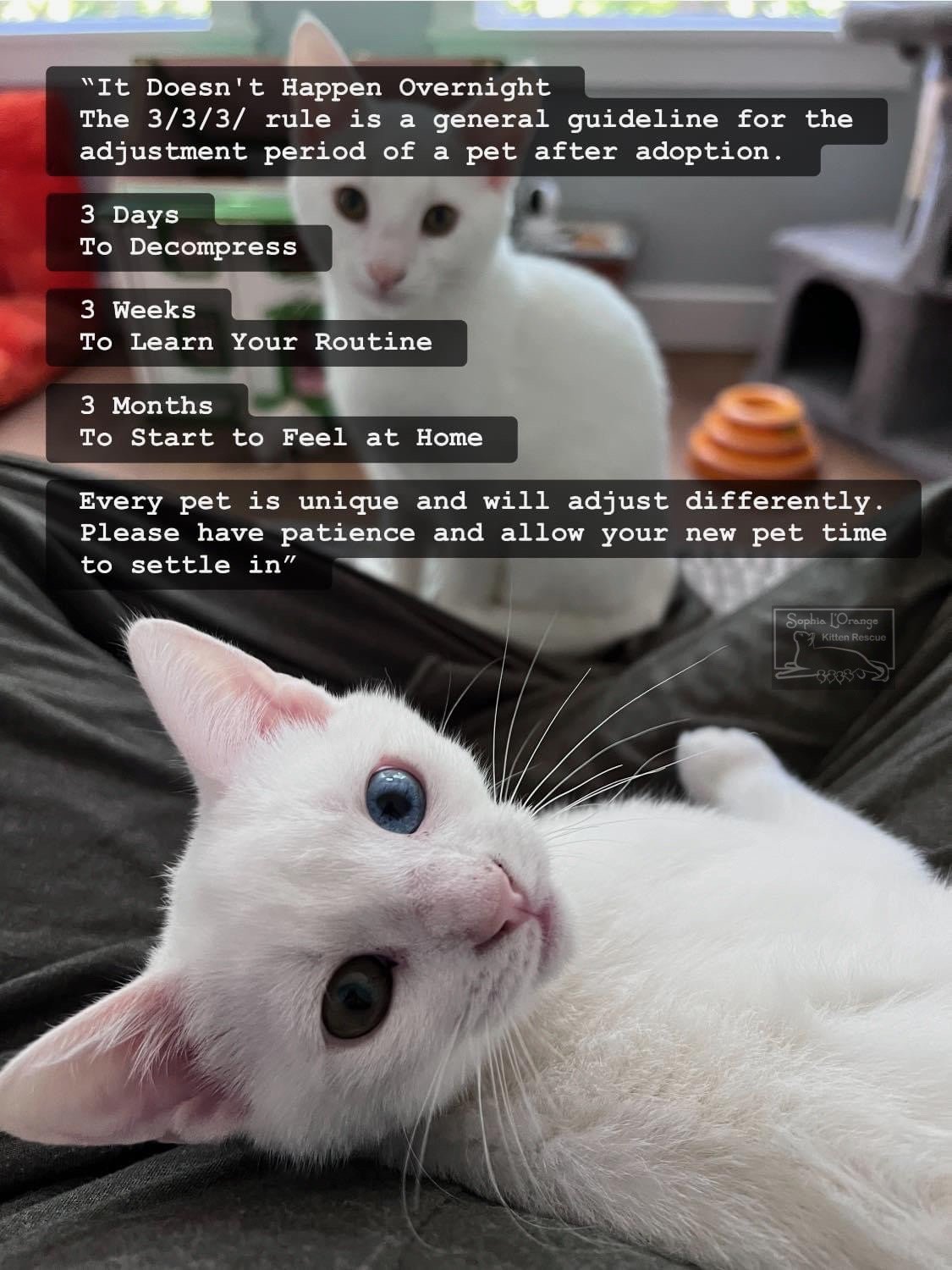
Adoption Instructions
Step 1
If you’d like to be considered as a home for any
of our adoptable kitties, you can complete an
adoption application online
*Please provide as much info as you can on the application, even if not marked as required, so the adoption coordinators can make the best assessment as to the right match.
** Please make sure to give your vet permission to release information to us as we check references.
Step 2
Prepare your house and family for a home visit
This can be done virtually, through online video conferencing (such as Zoom or through Facebook messenger) as well as by FaceTime. We'd just need to meet the whole family and be "walked" through the house.
During this visit too you’ll be able to meet the kitten in an environment in which is comfortable already and ask any questions of the foster.
Best Practices for your home visit:
Make sure everyone is home and available to talk
Do visit from a phone or tablet, as it is harder to walk around the home when on a laptop
Think about what questions you want to ask the foster about the kitten’s personality, likes, dislikes
Plan to meet for at least half an hour
Think about what room would work best for the kitten to start (should be one you are going to be comfortable in too)
Look around your home from the perspective of an active kitten; what will be climbed, jumped on, knocked over, eaten
Step 3
Preparing for the kitten
make sure that your new cat has his/her own sanctuary – preferably a room where your other animals will not be allowed to go. If you can keep the cat’s food and litter box in this room, and keep the door closed, then the animals can sniff each other under the door for a few days before meeting face to face. This will make things go a lot smoother, as they will most likely feel they have already “met.” Supervise the other animals’ behavior even at the door, reinforce playful, curious behavior and correct any aggression or obsession.
Step 4
Introducing the kitten
Remember when adopting, while some kitties are instantly loves, time, patience, and love is still needed for them to feel completely safe and comfortable in your home.
Remember every pet is unique and will adjust differently, but time and care make everything better. Please have patience and allow your new pet time to settle in”.
Kittens and Cats
Remember to give time for the transition
When introducing the kitten to resident cats, know that instinctively an adult cat will see a kitten and think there is a protective mom around so may hiss, swat, or growl to get the kitten to go away.
Once they realize the kitten is alone, they are more likely to take the kitten in.
Kittens and Dogs
When introducing to a dog for the first time, put dogs on a leash (or in a down if well trained and just allow the cat to walk by if he/she wants to. Evaluate both the dog and the cat. Is the cat fearful or curious? Is the dog happy/playful or chomping at the bit?
After introductions have occurred, keep in mind the following tips:
Never leave a cat and dog unsupervised, even if it looks like they get along great. A playful dog can still unintentionally harm a cat.
Make sure the cat has places to jump up to in each room or hide where a dog cannot get to him/her. Cats need this not only to protect their self, but to feel safe.
Playful chasing is normal, but always remind a dog to play nice/slow down/not run.
Do not allow a dog or another cat to stare down your new cat. A dog or cat should know that he/she is not allowed to obsess on the new cat.
The new cat may swipe at a dog or cat or hiss, in order to correct. This is usually a great help in ensuring another animal knows his/her place. But, keep an eye on interactions to ensure the cat does not injure another animal as well. A cat will also growl if scared and is an indication that more time is needed and the growling cat is scared.
Kittens and Kids
Cats and kids go together like peanut butter and jelly; they are great playmates and confidants. But, children must learn proper handling and discipline, and cats must learn self-control so that they do not play too rough. (Some cats like to use their claws, especially kittens and they are razor sharp)
Children should be supervised and taught that cats are beings, not dolls or toys to dress-up or handled constantly. Teach children not to tease or rile up the cat unnecessarily. This includes chasing around the house, which can scare a cat, who may bite if cornered or frightened.
Make sure your children know that it is not the cat’s fault if the cat chews up toys that are left out. Keeping doors shut and toys in toy boxes can help minimize damage. Make sure the cat has his/her own toys, and keep them in the same place all the time, like in a basket.
Children like the idea of caring for a cat, but the daily work of feeding, brushing, and cleaning up after the cat is not really suited for them. Recognize that the initial enthusiasm will wane quickly, and the true responsibility of caring for the cat will fall to the adults in the household.
Children should not play unsupervised with new kitties. For kittens, teach proper handling (pick up by the body, not the limbs), and limit interaction. Children need to be taught that a kitten’s mouthing is not biting, and that the kitten is not trying to hurt them. Perhaps most importantly, children must learn to properly discipline the cat/kitten, a sharp “no”. Children often react to a cats’ bad behavior by hitting the cat, this is unacceptable.
Step 5
It Doesn't Happen Overnight
Remember every pet is unique and will adjust differently, but time and care make everything better. Please have patience and allow your new pet time to settle in.
When adopting, while some kitties are instantly loves, time, patience, and love is still needed for them to feel completely safe and comfortable in your home.
Any new kitty needs time to acclimate to your home. Kittens often have an easier time because they aren’t used to being alone, but please remember 3/3/3 to manage your expectations and help them integrate as successful members of your family.
3 Days To Decompress
•Feeling overwhelmed
•May feel scared or unsure of what's going on
•Not yet comfortable to be "himself"
• May not want to eat or drink
•Shuts down and/or hides under furniture
•Tests the boundaries
3 Weeks To Learn Your Routine
•Starts settling in
•Feels more comfortable
•Realizes this could be his forever home
•Figures out his environment
• Gets into a routine
•Lets his guard down; beginning to show his true personality
• Behavior issues may appear
3 Months To Start to Feel at Home
•Finally feels completely comfortable in his home
•Begins to build trust and a true bond
• Gains a complete sense of security with his new family
• Sets into a routine

